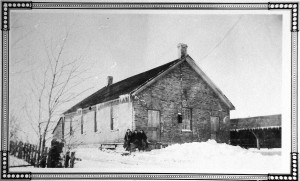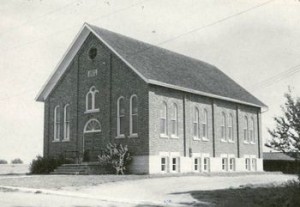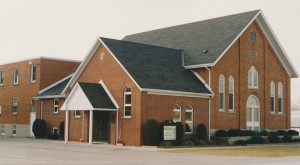A quick overview

The roots of Floradale Mennonite Church go back to 1856 when Mennonites were among the first settlers in the Elmira/Floradale area. When the Mennonite church divided in 1889 with one group choosing to be more progressive and the other wanting to maintain the old traditions, local Mennonites were mostly on the traditionalist side. Within a few years a progressive group was meeting that officially became Floradale Mennonite Church in 1896.
In the twentieth century the congregation changed its worship style so that how we live out our faith is now quite different from our Old Order cousins. We built a new red-brick church in 1936 and enlarged it in 1958. Renovations in 1986 gave us a new entrance and some extra space.
A more detailed history
Mennonites began trickling into the Floradale area in the 1840s. The land had been purchased by Mennonites decades earlier, but few families lived in the area until the 1850s when cheaper land in other locations was no longer readily available. In 1856 Mennonites began meeting in the home of Deacon William Hembling, north of what is now the village of Floradale. In 1868 the Mennonites purchased a building from the local Evangelical Association, also at the north end of the village. A few years later they moved the building to where the present North Woolwich meetinghouse is located on the corner of Floradale Road and Sandy Hills Drive.

When the Mennonite church divided in 1889 with one group choosing to be more progressive and the other wanting to maintain the old traditions, the Mennonites of Floradale were mostly on the traditionalist side. The traditionalists (Old Orders) kept the minister, deacon and the meetinghouse. But there were local people who were more progressive and soon a regular group was meeting which became Floradale Mennonite Church.
A new church was constructed in 1896 on a corner of Sam Weber’s farm where Clarence Diefenbacher’s house is now located. This small building had no basement. From the outside it was similar to a meetinghouse, but the fact that the pulpit was at the end rather than at the long side of the room meant the layout was more like a church than a meetinghouse. This congregation began a Sunday School program for children and adults and also held meetings on Sunday evenings. They soon were holding annual evangelistic services and began using four-part harmony on Sunday mornings. The Pennsylvania German dialect was still used for sermons for some years, but singing and reading quickly changed to English.

As part of the new Mennonite Conference of Ontario (formally organized in 1909), members of Floradale had the opportunity to participate in exciting new projects. A Bible School was begun in Kitchener so that young people could study in the winter months when work on the farm was less intensive. City missions were begun in places like Toronto and in 1917 Floradale was one of the congregations that began a women’s sewing circle to make clothing and other articles for those in need.
When a new church was built in Elmira in 1923 the Floradale congregation lost many of its members, but after a few years it was again a viable congregation. In 1936 the decision was made to construct an entirely new building on the east side of the village. This new church was built of red brick and had a basement. Its design was very similar to that of Elmira and St. Jacobs Mennonite. A common term for these churches was “red brick” Mennonites.
In 1935 Floradale was one of the early congregations to run a Vacation Bible School for children in the summer. For two weeks they brought in local children and taught them songs and Bible stories. Floradale is still participating in a combined VBS with Elmira Mennonite although it has been only one week for many years. Until the 1940s, Floradale and Elmira alternated their worship services and shared a minister.

In the 1940s, as Mennonites moved farther into Wellington County to the north, the Floradale congregation was involved in helping to start new congregations. Among those that Floradale helped to organize were Bethel Mennonite, Glen Allen Mennonite and Berea Mennonite. Glen Allen has since closed and today Berea is part of Community Mennonite in Drayton.
In the period during and after the Second World War (1939-1945), the women’s groups became particularly active, making and shipping many clothing items. They worked with an Ontario-wide Mennonite women’s organization, the Women’s Service and Missionary Auxiliary.
By the 1960s, the church was changing and no longer were pastors chosen by lot from within the congregation. Subsequent pastors were expected to have seminary training and were hired by the congregation. In the 1960s Mennonites at Floradale were slowly dropping the last parts of distinctive dress. They began to wear jewelry and women’s clothing and hairstyles eventually became similar to that of the rest of society. By the 1970s it was easier for people not raised in Mennonite homes to feel part of the congregation.

By the 1980s and 1990s worship at Floradale Mennonite Church had a lot of similarities to other Christian denominations. By that time there was a piano in the sanctuary and hymns were usually accompanied. A variety of lay people were used to lead worship and the service included such things as special music and congregational readings. Major renovations to the church building in 1986 made the basement more useable for church gatherings.
Within 15 years people began thinking that our facilities were in need of further upgrades. There was not a lot of extra space in the pews on Sunday mornings and when people gathered in the basement it was crowded and noisy. There was ongoing concern about the water system and the furnace. In 2001 a committee was given the task of exploring possibilities. Within five years a neighbouring property was purchased, providing enough space to build a large new facility behind the existing building.

For more information about the history of the congregation, Brent Bauman the historian published the book, Forged Anew: A History of the Floradale Mennonite Church in 1996.

